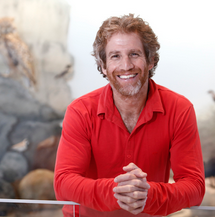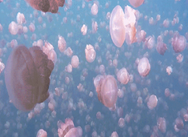Lectures & Lecturers
Dr. Zafrir Kuplik

9:30am - 10:30am - Enhanced Spontaneous Emergence of Giant Jellyfish Swarms in Warming Coastal Waters Under Climate Change - Dr. Zafrir Kuplik and Prof. Eyal Heifetz
Dr. Zafrir Kuplik

The recurrence and intensity of giant jellyfish swarms, in coastal waters throughout the world, is keep increasing due to the persistent rise of sea temperatures. Giant swarms, stretching up to lengths of a few hundred kilometers, composing up to a few million individuals, have a strong negative impact on biodiversity, as well as fishing, industry and tourism. It is yet unclear how these enormous swarms form on such a regular basis and move while maintaining their coherent structure.

While prior studies suggested that jellyfish are mostly passive, advected by sea currents, it is now understood that they are active swimmers, which interact with each other and respond to environmental stimuli. In this meeting, we will first learn about the biology of jellyfish and then show how we can mathematically model the dynamics of swarms, using fluid dynamics and active matter theory. The latter exploits concepts from theoretical physics such as statistical mechanics and phase transitions. In Particular, we will demonstrate scenarios in which swarms are emerging spontaneously and how the jellyfish collective behavior preserves the swarm's structure.

10:30am - 11:30am - Baroclinic Instability: The Quest of the Atmosphere for Thermal Equilibrium and the Reason for the Formation of Weather Systems in the Mid-Latitudes - Prof. Eyal Heifetz
Baroclinic instability is the major mechanism for generating weather systems in the mid-latitudes. In the lecture we will discuss a conceptual mechanistic minimal model for instability, based on interaction at a distance between counter-propagating Rossby waves. We will show further that the concept of counter-propagating vorticity (other than Rossby) waves interaction is quite general and applicable to different types of shear instabilities. If time permits, we will present a generalized low-order nonlinear dynamical system representing the essence of the instability mechanism.
Prof. Matt Ayres -

1pm - 2pm - Weather, Climate, Trade, and Pestilence - Prof. Matt Ayres
Prof. Matt Ayres -

Global change involves climate, land use, and biotic invasions. Globalization and land use change are drivers of increased greenhouse gas emissions and therefore climate change. At the same time, climate change affects globalization and land use (e.g., new shipping routes and newly possible plant production systems).
Climate change, globalization, and land use all contribute to the movement of biota around the world. Some of the new species, frequently insects or fungi, become highly consequential pests that can devastate crops, disrupt economies, harm humans, and alter global trade.
Limiting the unintentional introduction of plant pests is the most immediately soluble step in mitigating global change. The majority of plant pest introductions are via solid wood packing material and movement of live plants ("plants for planting"). There are sensible, and relatively inexpensive, proposals for federal action to manage these pathways of pest movement into the United States. The same principles would work elsewhere. The science of ecology has a growing capacity to understand how climate affects the potential distribution limits of species, and to predict which particular species of potential pests pose the greatest risk if introduced.
Paper: Prof. Ayres -Forest pests and their management in the Anthropocene1.pdf
Prof. Nili Harnik

2:00pm - 3:00pm - Extreme Weather Events Associated with Merging and Shifting of the Jet-Streams - Prof. Nili Harnik
Prof. Nili Harnik

The atmospheric circulation is governed by multiple scales. A main distinction is between global scales which are affected by the land-sea contrasts and topography, synoptic scales which drive much of our weather, and smaller - mesoscales to cloud scales, on which precipitation actually occurs. This talk will give an overview of how these scales of motion interact to give the atmospheric circulation, and specifically the variability of the jet streams. We will also go into some specific examples of how the distribution and variability of extreme weather in mid latitudes is affected.
Tom

3:30pm - 4:30pm - Coral-reef ecosystems under climate change -
Dr.Tom Shlesinger
Tom

Coral reefs are among the most diverse and productive ecosystems on Earth, supporting vast marine life and millions of people worldwide. Yet they are declining rapidly due to human pressures—pollution, overfishing, and especially climate change. Rising ocean temperatures trigger widespread coral bleaching and mortality, reducing reef resilience and their ability to keep pace with sea-level rise. However, beneath this overarching narrative lies a more complex ecological reality.
Despite global declines, some reefs defy expectations, showing surprising resistance and resilience. These exceptions highlight critical gaps in our understanding, assessments, and models—often rooted in oversimplified assumptions that treat the oceans as a uniform system, overlooking variation across scales and species.
This talk challenges the simplified story of uniform reef collapse and emphasizes the need for scale-explicit, species-specific approaches. Drawing on research from the Red Sea, Papua New Guinea, Palau, and global meta-analyses, I will present case studies showing how local and often-overlooked factors interact with climate change to shape reef futures. We will explore three central questions: (1) How can demographic models reveal subtle species-level differences and predict population trajectories? (2) How do spatial scales—from local to global—shape our view of climate refugia? (3) What can extreme environments teach us about coral adaptive capacity?
Understanding these dynamics is key to advancing our fundamental knowledge and to better conserving, managing, and predicting the future of coral reefs under climate change.
Paper: Tom Shlesinger - Coral‐bleaching responses to climate change across biological scales.pdf